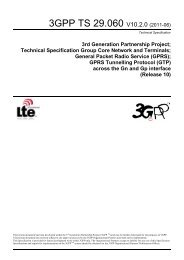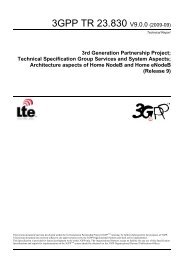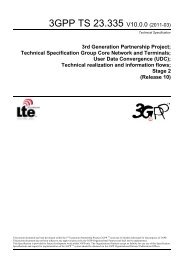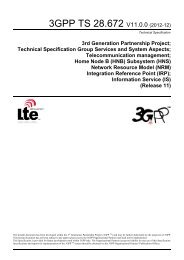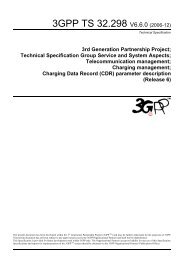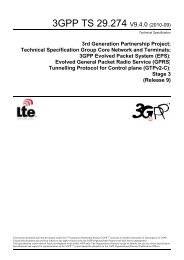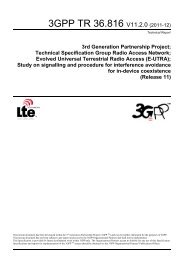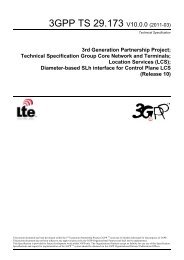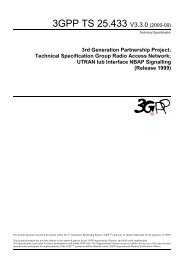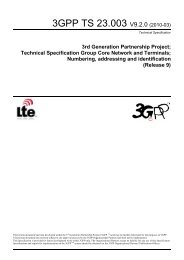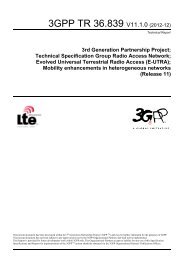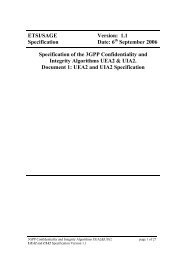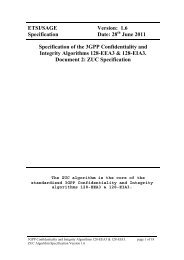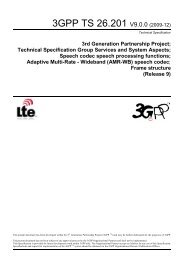3GPP TS 36.212, "Multiplexing and channel coding"
3GPP TS 36.212, "Multiplexing and channel coding"
3GPP TS 36.212, "Multiplexing and channel coding"
You also want an ePaper? Increase the reach of your titles
YUMPU automatically turns print PDFs into web optimized ePapers that Google loves.
Release 8<br />
22<br />
<strong>3GPP</strong> <strong>TS</strong> <strong>36.212</strong> V8.1.0 (2007-11)<br />
Code block segmentation <strong>and</strong> code block CRC attachment are performed according to subclause 5.1.2.<br />
The bits after code block segmentation are denoted by c r0 , cr1,<br />
cr2<br />
, cr3<br />
,..., cr( K r −1)<br />
, where r is the code block number<br />
<strong>and</strong> K r is the number of bits for code block number r.<br />
5.2.2.3 Channel coding of UL-SCH<br />
Code blocks are delivered to the <strong>channel</strong> coding block. The bits in a code block are denoted by<br />
c r0 , cr1,<br />
cr2<br />
, cr3<br />
,..., cr( K r −1)<br />
, where r is the code block number, <strong>and</strong> K r is the number of bits in code block number r.<br />
The total number of code blocks is denoted by C <strong>and</strong> each code block is individually turbo encoded according to<br />
subclause 5.1.3.2.<br />
( i)<br />
( i)<br />
( i)<br />
( i)<br />
After encoding the bits are denoted by dr0 , dr<br />
1<br />
, dr2<br />
, dr3<br />
,..., d<br />
r( Dr<br />
− 1)<br />
, with i = 0,1, <strong>and</strong> 2 <strong>and</strong> where Dr<br />
is the number of<br />
bits on the i-th coded stream for code block number r, i.e. D K + 4 .<br />
5.2.2.4 Rate matching<br />
( i)<br />
r = r<br />
Turbo coded blocks are delivered to the rate matching block. They are denoted by dr0 , dr<br />
1<br />
, dr2<br />
, dr3<br />
,..., d<br />
r( Dr<br />
− 1)<br />
,<br />
with i = 0,1, <strong>and</strong> 2 , <strong>and</strong> where r is the code block number, i is the coded stream index, <strong>and</strong> D r is the number of bits in<br />
each coded stream of code block number r. The total number of code blocks is denoted by C <strong>and</strong> each coded block is<br />
individually rate matched according to subclause 5.1.4.1.<br />
After rate matching, the bits are denoted by e r0 , er1,<br />
er2,<br />
er3,...,<br />
er( E r −1)<br />
, where r is the coded block number, <strong>and</strong> where<br />
E r is the number of rate matched bits for code block number r.<br />
5.2.2.5 Code block concatenation<br />
The bits input to the code block concatenation block are denoted by e r0 , er1,<br />
er2,<br />
er3,...,<br />
er( E r −1)<br />
for r = 0,...,<br />
C −1<br />
<strong>and</strong><br />
where E r is the number of rate matched bits for the r-th code block.<br />
Code block concatenation is performed according to subclause 5.1.5.<br />
The bits after code block concatenation are denoted by f 0 , f1,<br />
f2,<br />
f3,...,<br />
f G −1<br />
, where G is the total number of coded bits<br />
for transmission excluding the bits used for control transmission, when control information is multiplexed with the UL-<br />
SCH transmission.<br />
5.2.2.6 Channel coding of control information<br />
The coding rate of the control information when multiplexed with the data transmission is given by the modulation<br />
scheme <strong>and</strong> the coding rate used for the UL-SCH transmission. Different coding rates for the control information are<br />
achieved by allocating different number of coded symbols for its transmission.<br />
The bits output from the control information coding are denoted by q 0 , q1,<br />
q2,<br />
q3,...,<br />
q Q −1<br />
.<br />
[Note from the editor: the value Q needs to be a multiple of Q m so that modulation symbols do not mix control <strong>and</strong> data<br />
information.]<br />
5.2.2.7 Data <strong>and</strong> control multiplexing<br />
The control <strong>and</strong> data multiplexing is performed such that control is present on both slots in the subframe <strong>and</strong> so that the<br />
control is mapped to resources around the demodulation reference signals. In addition, the multiplexing ensures that<br />
control <strong>and</strong> data information are mapped to different modulation symbols.<br />
The inputs to the data <strong>and</strong> control multiplexing are the coded bits of the control information denoted<br />
by q0 , q1,<br />
q2,<br />
q3,...,<br />
q Q −1<br />
<strong>and</strong> the coded bits of the UL-SCH denoted by f 0 , f1,<br />
f 2 , f 3 ,..., f G −1<br />
. The output of the data <strong>and</strong><br />
( i)<br />
( i)<br />
( i)<br />
( i)<br />
( i)<br />
<strong>3GPP</strong>



